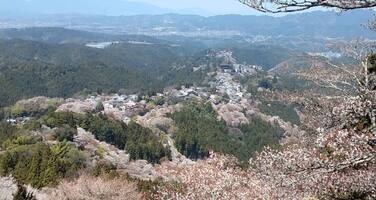Sacred Sites and Pilgrimage Routes in the Kii Mountain Range
Factors affecting the property in 2006*
- Management systems/ management plan
International Assistance: requests for the property until 2006
Total amount approved : 0 USD
Missions to the property until 2006**
Conservation issues presented to the World Heritage Committee in 2006
At it 28th session, the World Heritage Committee inscribed the Sacred Sites and Pilgrimage Sites in the Kii Mountain Range on the World Heritage List and requested the Japanese authorities to develop a more detailed management plan and medium-term strategy to address the sustainable management of both the natural and cultural aspects of the property. It was suggested that such a plan might consider the appropriate placement of overhead wires and visitor facilities. The State Party was asked to submit the plan for examination by the Committee at its 30th session in 2006.
On 17 February 2006 the State Party submitted a preservation and management plan for the site produced by the Three Prefectures Council for the World Heritage property. The inscribed property consists of three sacred sites, Yoshino and Omine, Kumano Sanzan, and Koyasan, in the heavily forested Kii Mountains, and a complex pattern of tracks and paths which link the sites together and to the ancient capitals of Nara and Kyoto, which flourished from the 6th century to 1868. The sites are distributed through three Prefectures: Mie, Nara and Wakayama.
The Plan has been prepared by the Boards of Education of Mie, Nara and Wakayama Prefectures in cooperation with the Agency for Cultural Affairs. To support the overall Plan, the three Prefectures have produced supplementary plans for the sites within their territories. Furthermore, it is stated that these territory plans will be augmented by specific preservation and management plans for individual historic sites. The preparation of the management plan was guided by a Coordinating Academic Committee for the World Heritage property, consisting of specialists from each of the Prefectures, and by Academic Committees within each of the Prefectures. These latter included relevant experts and representatives of local people.
The main overall Plan sets out six basic Principles of Preservation and Management. These are:
a) Necessary identification and documentation;
b) Criteria for modification;
c) Recognition of value as living heritage;
d) Integration of cultural and natural features;
e) Conservation and utilization (as a means of ensuring preservation and management);
f) Public participation.
The Plan stresses the need for landscape scale planning encompassing monuments, the natural environment and the overall cultural landscapes that includes many modern interventions, such as roads. It also stresses the need to consider appropriate management of natural elements that produce an ‘awe-inspiring atmosphere’.
In order to implement the Plan, the following is recommended:
a) Full-time officers within each of the relevant city governments, town governments and village governments;
b) Reinforced support provided by Prefectural governments;
c) Improved coordination amongst custodial bodies, Prefectural governments and the Agency for Cultural Affairs through the establishment of a Three Prefectures Council, which will over-arch the Three Prefectures’ Expert Committee and other expert Prefectural Committees;
d) Increased educational and communal activities;
e) Training of local staff.
The three Prefectural Plans set out in detail the cultural and natural elements of the property, using an agreed methodology for identifying component features, both cultural and natural, together with their use and vulnerabilities and recommendations for improvement relating to, for instance, visitor facilities and overhead wires. They also give details of the collaborative arrangement in place within each of the prefectures such as Promotion Councils, Liaison meetings (liaison between councils) and arrangement to coordinate activities with owners of shrines, paths and forests.
Overall the Plans are very accessible documents. Although detailed and thorough, they are presented in a user-friendly way using straightforward language and encapsulate well the values of the sites as well as their challenges. What the plans do not set out are any benchmarks or ways of monitoring or evaluating the effectiveness of the Plans. It would be helpful if these aspects could be integrated into the plans.
Summary of the interventions
Decisions adopted by the Committee in 2006
30 COM 7B.66
State of Conservation (Sacred Sites and Pilgrimage Routes in the Kii Mountain Range)
The World Heritage Committee,1. Having examined Document WHC-06/30.COM/7B,
2. Recalling Decision 28 COM 14B.28 adopted at its 28th session (Suzhou, 2004),
3. Commends the State Party for the preparation of the overall Preservation and management plan for the Sacred Sites and Pilgrimage Routes in the Kii Mountain Range World Heritage Site, and for the three supplementary Prefectural Plans;
4. Suggests that these Prefectural Plans could be complemented, in time, by benchmarks and indicators, in order to evaluate the effectiveness of these Plans over time.
Draft Decision: 30 COM 7B.66
The World Heritage Committee,
1. Having examined Document WHC-06/30.COM/7B,
2. Recalling Decision 28 COM 14B.28adopted at its 28th session (Suzhou, 2004),
3. Commends the State Party for the preparation of the overall Preservation and management plan for the Sacred Sites and Pilgrimage Routes in the Kii Mountain Range World Hertiage Site, and for the three supplementary Prefectural Plans;
4. Suggests that these Prefectural Plans could be complemented, in time, by benchmarks and indicators, in order to evaluate the effectiveness of these Plans over time.
Exports
* :
The threats indicated are listed in alphabetical order; their order does not constitute a classification according to the importance of their impact on the property.
Furthermore, they are presented irrespective of the type of threat faced by the property, i.e. with specific and proven imminent danger (“ascertained danger”) or with threats which could have deleterious effects on the property’s Outstanding Universal Value (“potential danger”).
** : All mission reports are not always available electronically.


